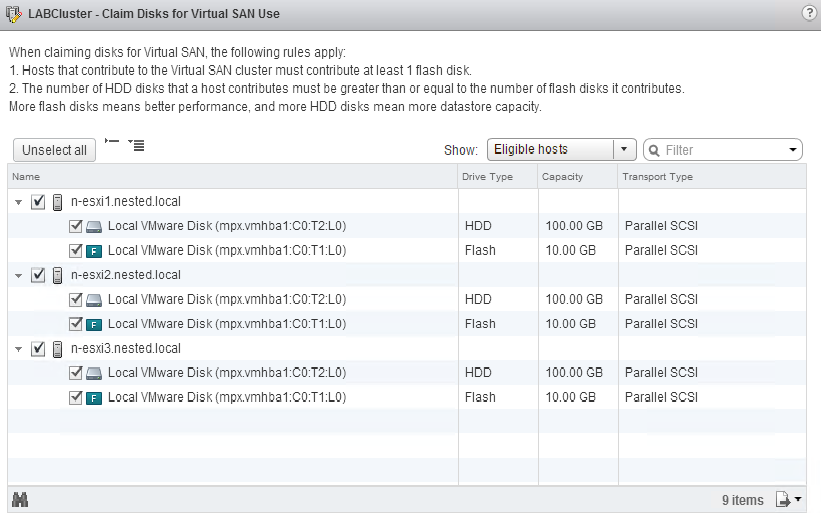VSAN presents shared storage to ESXi hosts across a vSphere Cluster. Each host providing storage to the VSAN cluster requires the following:
- Solid-State Disks (SSD) to provide performance
- Hard Disk Drives (HDD) or SSDs to provide capacity
- A disk controller
- Network connectivity between hosts
As with all hardware in a vSphere environment, the hardware supporting VSAN must be verified on the Hardware Compatibility List (HCL) located at http://www.vmware.com/resources/compatibility/search.php?deviceCategory=vsan. Compatibility of the SSD, HDD, and disk controller, including the firmware, should all be validated on the HCL. Many server hardware vendors offer VSAN-ready nodes that have been preconfigured with supported hardware/firmware.
VSAN can be deployed as a hybrid, SSD and HDD disks, or as All-Flash. VSAN requires network connectivity between hosts. A 10 GbE network should be used for VSAN to provide the best performance, but 1 GbE is supported in a hybrid VSAN. 10 GbE is required for an All-Flash VSAN. A VMkernel is configured and enabled for VSAN traffic, as shown in the following screenshot:

VSAN is enabled on a vSphere Cluster. ESXi hosts participating in VSAN, regardless of whether the host is providing storage or consuming storage, must be in the same cluster. The VSAN storage cannot be directly consumed by hosts outside the cluster. VSAN is enabled by simply turning on VSAN for a vSphere Cluster, as shown in the following screenshot:

When enabling VSAN, the disk can be automatically or manually claimed. Disks are claimed to be used by VSAN and placed into disk groups. A disk group must contain at least one flash (SSD) disk and one or more HDDs. A single host can be configured with up to five disk groups and each disk group, can contain up to eight disks, one SSD, and seven HDDs. All Flash disk groups are also supported. In a VSAN disk group, the Flash disk provides performance and the HDD disk provides capacity. Claiming disks for VSAN is shown in the following screenshot:

When sizing VSAN, VMware recommends the SSDs be sized to 10 percent of the HDD capacity in a disk group. For example, if there is 1 TB of HDD capacity, the SSD should be at least 100 GB. The capacity of the disk group is the sum of the HDD capacity. If there are three 1 TB HDDs in the disk group, the group will provide 3 TB of capacity storage. The size of the VSAN in the datastore is the aggregate of all disk groups claimed by VSAN across all hosts.
Three hosts, participating in a VSAN cluster, each with a disk group of three 1 TB HDDs to provide capacity, will present a VSAN datastore with approximately 9 TB of usable capacity.
When sizing VSAN, it is important to take into account Failures To Tolerate (FTT) and Fault Domain policies for virtual machines. A virtual machine consuming 100 GB of storage stored on a VSAN datastore with the FTT policy configured to 1 will consume 2 x the capacity, or 200 GB. This is due to the virtual machine storage being duplicated across two hosts so that the virtual machine disks will be available in the event that a single host fails. If the FTT is set to 2, then a virtual machine will consume 3 x the capacity. We will take a deeper look at storage policies later in this chapter.
